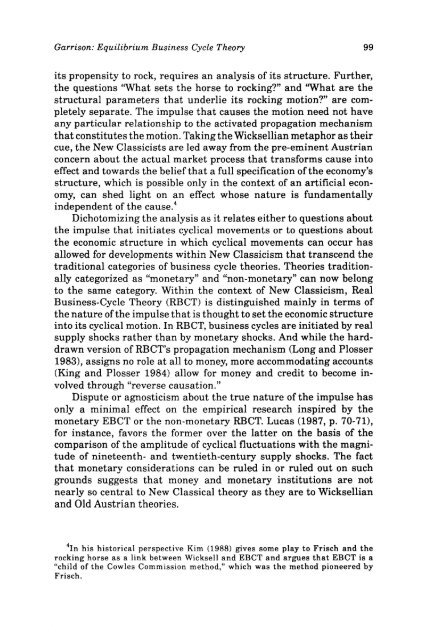Review of Austrian Economics - The Ludwig von Mises Institute
Review of Austrian Economics - The Ludwig von Mises Institute
Review of Austrian Economics - The Ludwig von Mises Institute
Create successful ePaper yourself
Turn your PDF publications into a flip-book with our unique Google optimized e-Paper software.
Garrison: Equilibrium Business Cycle <strong>The</strong>ory 99<br />
its propensity to rock, requires an analysis <strong>of</strong> its structure. Further,<br />
the questions 'What sets the horse to rocking?" and "What are the<br />
structural parameters that underlie its rocking motion?" are completely<br />
separate. <strong>The</strong> impulse that causes the motion need not have<br />
any particular relationship to the activated propagation mechanism<br />
that constitutes the motion. Taking the Wicksellian metaphor as their<br />
cue, the New Classicists are led away from the pre-eminent <strong>Austrian</strong><br />
concern about the actual market process that transforms cause into<br />
effect and towards the belief that a full specification <strong>of</strong> the economy's<br />
structure, which is possible only in the context <strong>of</strong> an artificial economy,<br />
can shed light on an effect whose nature is fundamentally<br />
independent <strong>of</strong> the cause. 4<br />
Dichotomizing the analysis as it relates either to questions about<br />
the impulse that initiates cyclical movements or to questions about<br />
the economic structure in which cyclical movements can occur has<br />
allowed for developments within New Classicism that transcend the<br />
traditional categories <strong>of</strong> business cycle theories. <strong>The</strong>ories traditionally<br />
categorized as "monetary" and "non-monetary" can now belong<br />
to the same category. Within the context <strong>of</strong> New Classicism, Real<br />
Business-Cycle <strong>The</strong>ory (RBCT) is distinguished mainly in terms <strong>of</strong><br />
the nature <strong>of</strong> the impulse that is thought to set the economic structure<br />
into its cyclical motion. In RBCT, business cycles are initiated by real<br />
supply shocks rather than by monetary shocks. And while the harddrawn<br />
version <strong>of</strong> RBCT's propagation mechanism (Long and Plosser<br />
1983), assigns no role at all to money, more accommodating accounts<br />
(King and Plosser 1984) allow for money and credit to become involved<br />
through "reverse causation."<br />
Dispute or agnosticism about the true nature <strong>of</strong> the impulse has<br />
only a minimal effect on the empirical research inspired by the<br />
monetary EBCT or the non-monetary RBCT. Lucas (1987, p. 70-71),<br />
for instance, favors the former over the latter on the basis <strong>of</strong> the<br />
comparison <strong>of</strong> the amplitude <strong>of</strong> cyclical fluctuations with the magnitude<br />
<strong>of</strong> nineteenth- and twentieth-century supply shocks. <strong>The</strong> fact<br />
that monetary considerations can be ruled in or ruled out on such<br />
grounds suggests that money and monetary institutions are not<br />
nearly so central to New Classical theory as they are to Wicksellian<br />
and Old <strong>Austrian</strong> theories.<br />
4 In his historical perspective Kim (1988) gives some play to Frisch and the<br />
rocking horse as a link between Wicksell and EBCT and argues that EBCT is a<br />
"child <strong>of</strong> the Cowles Commission method," which was the method pioneered by<br />
Frisch.

















